|
Getting your Trinity Audio player ready...
|
Facebook’s record fine, The Athletic’s milestone, the growth of smart speakers, live podcasts and global advertising markets.
Here’s our regular round-up of the Top 10 stats from the past month:
1: Global advertising market worth $639 billion in 2019, up +4.6%
Global ad spend is forecast to increase by $28 billion this year, Zenith predicts. Almost half of this growth ($13bn) will come from the United States.
As FIPP: The Network for Global Media recently pointed out “The United States advertising market is huge, standing at roughly $229 billion dollars.”
“The combined advertising spending of the other nine markets in the top ten just pass the ad spend in the US, rounding out to around $245 billion collectively.”
Looking ahead, Zenith predicts that “The US will be by some distance the leading contributor of new ad dollars to the global market over the next three years, followed by China.”
“Between 2018 and 2021 we forecast global advertising expenditure to increase by US$85bn in total. The US will contribute 46% of this extra ad expenditure and China will contribute 10%, followed by the UK at 5% and India at 4%.”
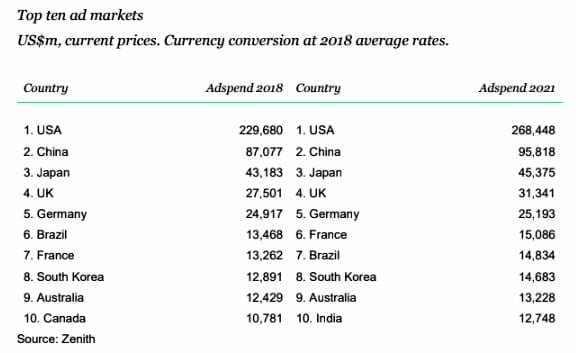
2: Facebook fined $5 billion by the Federal Trade Commission (FTC)
Last month saw the social networking giant fined $5 billion following failures to live up to privacy commitments agreed with the FTC back in 2012.
“The size of the $5 billion penalty, as well as the percentage of profits it represents, will provide significant deterrence not just to Facebook, but to every other company that collects or uses consumer data,” the FTC said in a statement. “The penalty the Commission has negotiated is over 20 times greater than the largest GDPR fine to date,” they commented.
“The penalty is equivalent to about 16% of the company’s 2018 operating expenses, the day-to-day cost of running the business,” Theo Francis wrote in the Wall Street Journal.
“Put another way, it amounts to 59 days of ordinary expenses such as research and development spending, marketing and administrative costs for the social-media giant. Facebook reported holding about $13.9 billion in cash and equivalents at the end of June, plus $34.7 billion in marketable securities.”

The settlement established an independently-appointed privacy committee which will be incorporated into Facebook’s board. Facebook will now have to conduct pre-launch “privacy reviews” for any new or amended product, service and practice. They will also have to notify the FTC if the data of at least 500 users has been compromised.
“Facebook has to abide by the settlement’s terms and conditions for 20 years. For perspective, the company was founded 15 years ago, in 2004,” wrote Andrew Keshner at MarketWatch.
“Furthermore,” he added, “the agreement doesn’t just apply to Facebook and how users interact with the site. The same set of 20-year reporting and compliance standards also apply to Instagram and WhatsApp, the image sharing and messaging platforms that Facebook owns.”
3: Over a quarter of the world’s WhatsApp users are in India
Of WhatsApp’s 1.5 billion global users, 400 million are on the sub-continent, reports the Times of India.
“For almost everything we do, increasingly we are looking at how people are using the product in India and using that to find things to build, and then we will do them globally,” WhatsApp’s global head Will Cathcart told the paper.
In February, we noted some of the steps that the messaging network had taken in India (and elsewhere) to counter the spread of misinformation; including outreach in the form of roadshows a primetime TV advertising campaign and reducing the number of times a message can be forwarded. Cathcart
Currently, over 1 million businesses use WhatsApp Business in the country, potentially an area for huge growth, given the number of consumers who use the service.
“We are excited about the opportunity for payments to really help the businesses and people that are interacting with it. It could be transformational,” Catchart said.
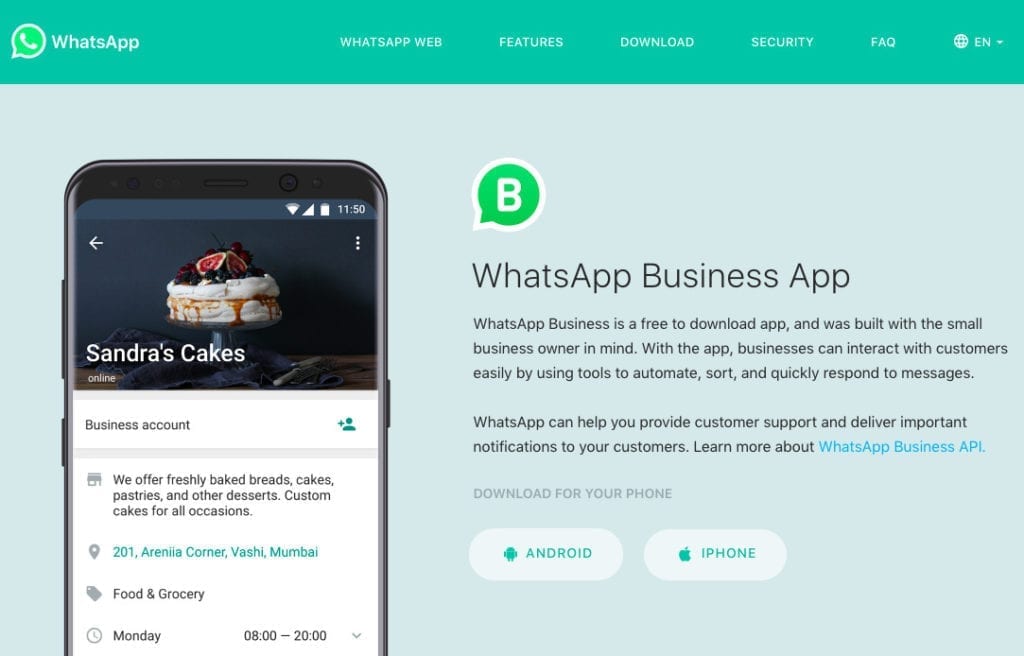
4: Amazon has the fastest growing music streaming service
According to data from Midia Research, and published by the Financial Times (paywall), Amazon’s Music Unlimited streaming service grew by more than 70% in the past year.
Writing in Ars Technica, Samuel Axon observed that despite this growth, Amazon’s service is less popular than some others.
- Spotify has more than 100 million users.
- Apple Music has about 60 million subscribers.
- Amazon has approximately 32 million subscribers.
As Axon explained:
“Midia Research credits the rapid growth of Amazon Unlimited Music to the proliferation of Amazon Echo smart speakers and other devices with Alexa. While these devices can play music from other services like Spotify, they default to Amazon services in many cases.
For example, if you ask Alexa to play David Bowie’s “Heroes” on a Sonos One speaker, Amazon’s streaming music service will be used. You have to say “Play David Bowie’s ‘Heroes’ on Spotify” to get a different result.”
Head of Amazon Music, Steve Boom, also highlighted that their service also tends to reach a different demographic. Around 14% of Amazon music subscribers are aged 55 years or older, compared to 5% of Spotify’s customers.
“For the industry to reach its full potential, we can’t just look at 15- to 22-year-olds,” Boom said in the FT. “We’re not battling for the same customers as everyone else.”
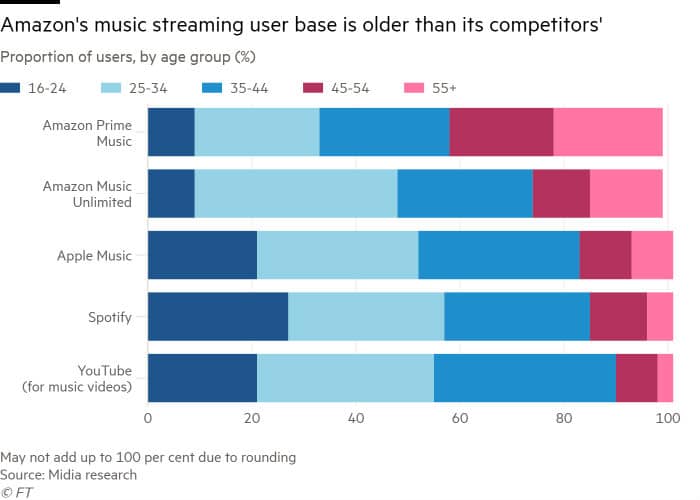
5: Podcast events have increased by over 2,000% in the past six years
Podcast events are making a killing, wrote Sara Fischer at Axios, citing data from Vivid Seats, one of the largest independent ticket vendors in North America, which found that “The number of events that have sold based on podcasts has increased by over 2000% in the past six years.”
I highlighted the opportunity afforded by Events as a revenue stream for publishers – including podcasters – earlier this year, as part of a series “50 Ways to Make Media Pay” (consolidated and revised into a downloadable full report here).
Fischer reflected that “Many of the most expensive tickets sell to shows that are personality-driven.”
Although this is still a small market, it is one that is growing. Michael O’Neil, Head of Public Policy and Community Engagement at Vivid Seats told Axios “we’ve seen the enormous growth of fans looking to see their favorite podcast hosts in person… fans are clearly enjoying more tailored forms of live entertainment that hardly even existed a decade ago.”
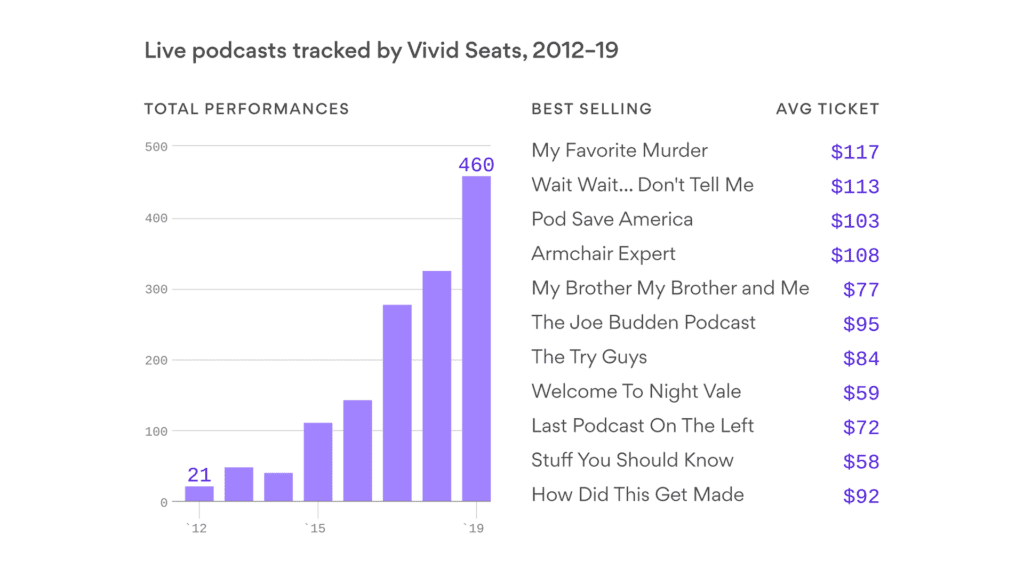
Read more about the growth of podcasts, in The Publisher’s Guide to Podcasting, a special insight report which we published this month, written by regular WNIP contributor and Media Voices podcast co-founder Esther Kezia Thorpe.
6: Big variances in popular podcast categories in U.S. and Europe
A fascinating study from the podcast solutions company Voxnest “found that listening behaviors, based on the podcast’s category, significantly differ.”
In a summary of their findings, the company stressed that “as a podcaster, publishing time, based on the podcast’s category, truly matters.” Adding, that these insights “also gives advertisers the data they need to partner with particular podcast categories as an opportunity to develop more time-specific ads.”
Aside from showing major variances in the time of day that audiences consume certain podcast genres, consumption of material hosted on Voxnest’s network, also showed significant differences:
Top five podcast categories in the U.S.:
1. Religion
2. Culture
3. Sports
4. History
5. News & Information
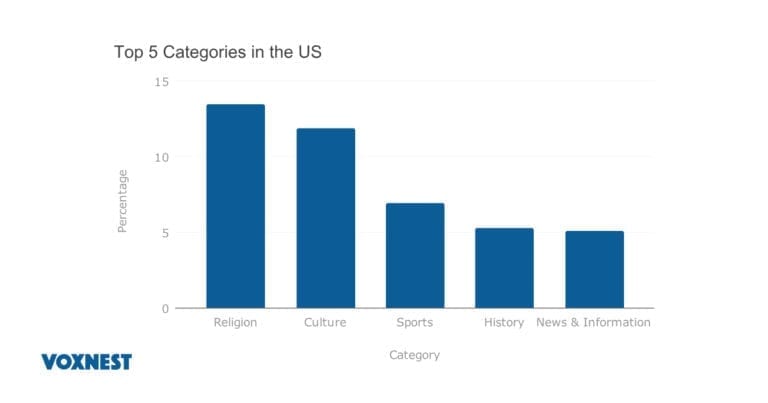
Top five podcast categories in Europe:
1. Business
2. Culture
3. Psychology
4. History
5. Education
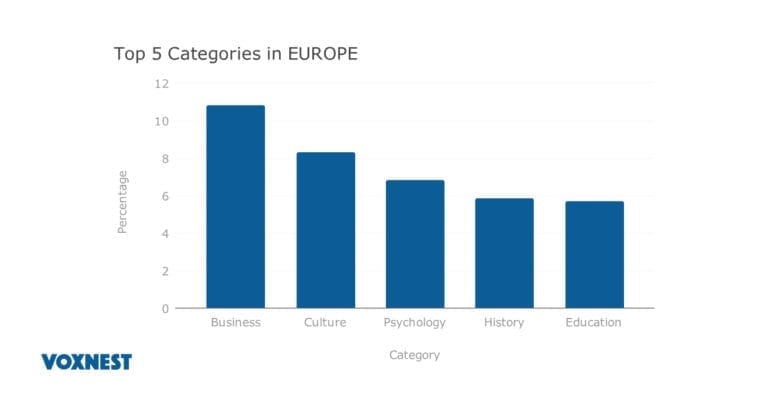
7: More than one in five Americans now own a smart speaker
The Smart Audio Report from NPR and Edison Research stated that 21% of Americans aged 18+ now own a Smart Speaker. That’s akin to around 53 million people.
As evidence of the rapid take-up of this technology, there were 14 million new smart speaker owners in 2018.
Thirty percent of smart speaker owners have three of more of these devices.
Subsequently, at the end of last year, there were nearly 120 million smart speakers in households across the United States.
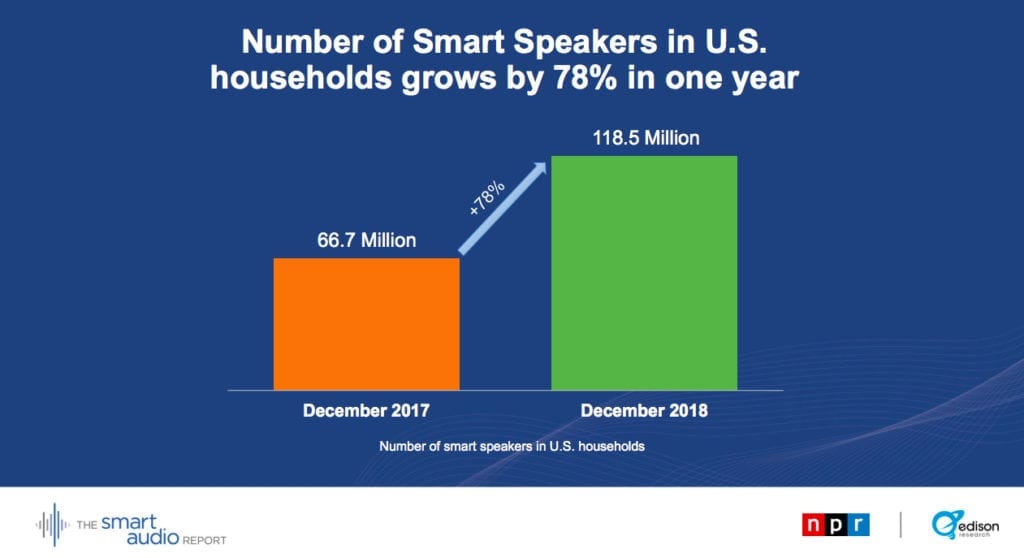
8: The Athletic hits half a million subscribers
Launched three years ago, The Athletic, is an ad-free, online-only site focusing on sports.
As James Mirtle, editor-in-chief The Athletic Canada outlined in a detailed explanation last year about “Why The Athletic has a paywall,” the site was founded with a belief that “The Athletic would not happen on an ad revenue model.”
“Without the pressure of generating clicks or meeting arbitrary deadlines, The Athletic’s editorial team is doing the best work of their careers…Putting up a paywall is not The Athletic being greedy. We remain very much a start-up and all of the money we receive right now goes to the product. On a basic level, the more that people subscribe, the more we can invest in bringing good sports journalism to other markets and making the product more valuable for subscribers.”
Commenting on the development, Bloomberg’s Ira Boudway shared that “Since launching in Chicago three years ago, the Athletic has expanded to nearly 50 cities in the U.S. and Canada and hired hundreds of sports reporters and editors, often from local newspapers. It covers roughly 270 teams from the NFL, NBA, MLB, NHL and college sports.”
“The site has yet to show an overall profit but is profitable in all but a few markets,” and new cities routinely achieve profitability within a year, she wrote quoting Alex Mather, co-founder and chief executive officer. “We’ll end the year somewhere close to a million [subscribers],” Mather predicted.
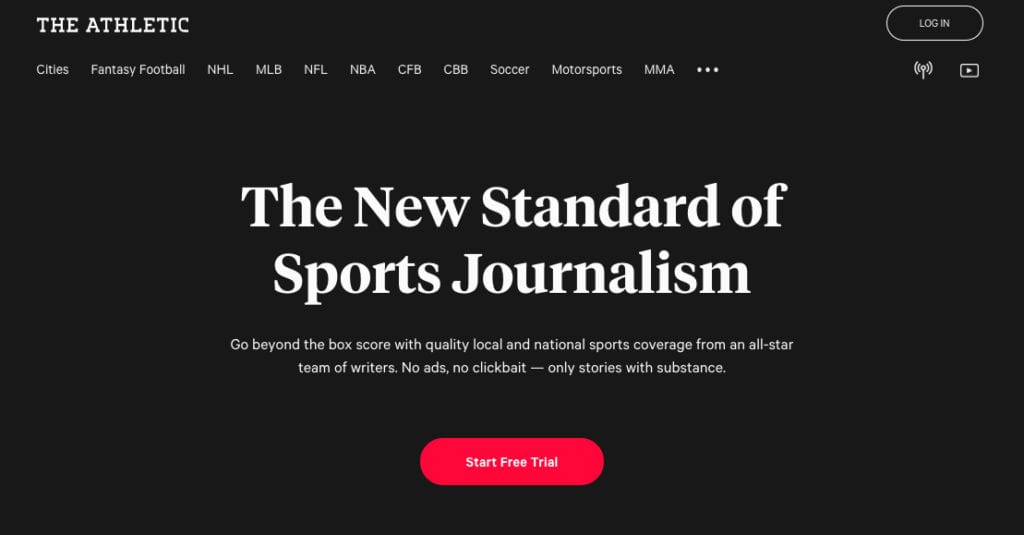
9: Graydon Carter launches new paid weekly publication
Although billed in many quarters as a newsletter, Graydon Carter, the former Vanity Fair editor in chief’s latest venture – Air Mail – is more than that.
Dropping every Saturday at 6 am EST, the current issue features profile and photo galleries, as well as magazine style articles on food, travel and crime.
It features 31 people on the masthead – including two editors, four deputy editors and sections on style, books, arts and more.
According to an article in the New York Times earlier this year, “Each issue is intended to have a single sponsor, ideally a luxury advertiser drawn to an upscale readership. Air Mail has also secured backing from TPG Growth, the private equity powerhouse that has a stake in Creative Artists Agency and Vice.”
“My best guess regarding audience is that it will be made up of people with active passports and an understanding of the world beyond our borders,” Carter told the New York Post last month. “The mission is to produce a sprightly Saturday morning digital weekly that is international in flavor and easy on the eyes.”

10: 47% of journalists believe the way most companies share information with them is outdated
Muck Rack, a website support PR professionals and journalists alike, released its 2019 State of Journalism round-up last month, offering insights into how journalists use social media and their relationship with PR teams.
Eighty-three percent of those surveyed said Twitter is their “most valuable” network, up from 70% last year; and 76% of journalists surveyed claimed they are more likely to cover a story if offered an exclusive.
“Journalists love their Twitter accounts. But is sliding into their DMs the best way to pitch a story?,” asked PR News’ Nicole Schuman.
“Nope. According to the study, the most preferred method among journalists is email. Add a brief, descriptive subject line, with a message length of no more than two to three paragraphs, and they just might open your pitch.”
Similarly, although journalists survey said they were using Twitter more than this time last year, it’s not where they first go for news. Online magazines or newspapers were the primary go-to source for more than half of them.
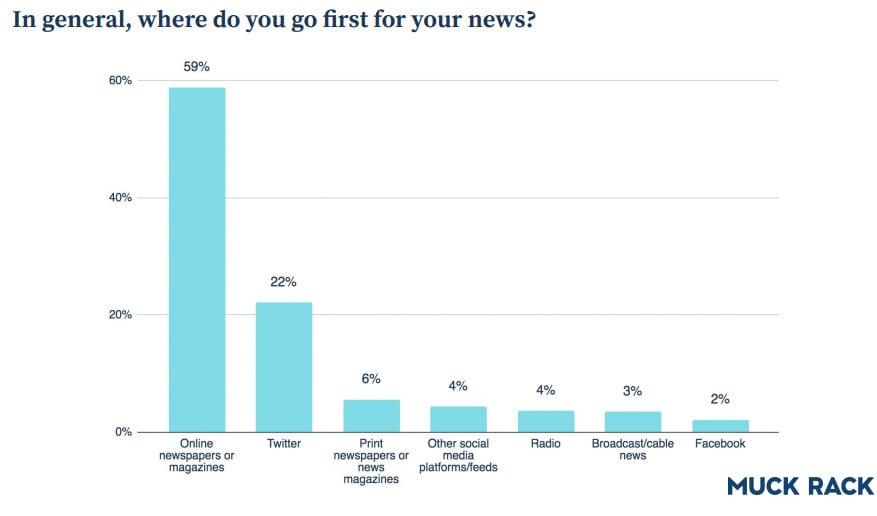
Source: Muck Rack “State of Journalism 2019”



